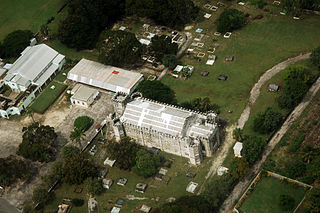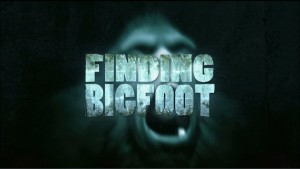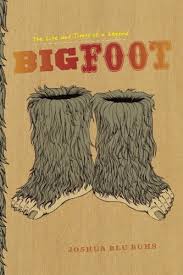Related Research Articles

Bigfoot, also commonly referred to as Sasquatch, is a large and hairy human-like mythical creature alleged by some to inhabit forests in North America, particularly in the Pacific Northwest. Bigfoot is featured in both American and Canadian folklore, and has become an enduring icon in popular culture.
Cryptozoology is a pseudoscience and subculture that searches for and studies unknown, legendary, or extinct animals whose present existence is disputed or unsubstantiated, particularly those popular in folklore, such as Bigfoot, the Loch Ness Monster, Yeti, the chupacabra, the Jersey Devil, or the Mokele-mbembe. Cryptozoologists refer to these entities as cryptids, a term coined by the subculture. Because it does not follow the scientific method, cryptozoology is considered a pseudoscience by mainstream science: it is neither a branch of zoology nor of folklore studies. It was originally founded in the 1950s by zoologists Bernard Heuvelmans and Ivan T. Sanderson.

The Patterson–Gimlin film is an American short motion picture of an unidentified subject that the filmmakers have said was a Bigfoot. The footage was shot in 1967 in Northern California, and has since been subjected to many attempts to authenticate or debunk it.

The Yeti is an ape-like creature purported to inhabit the Himalayan mountain range in Asia. In Western popular culture, the creature is commonly referred to as the Abominable Snowman. Many dubious articles have been offered in an attempt to prove the existence of the Yeti, including anecdotal visual sightings, disputed video recordings, photographs, and plaster casts of large footprints. Some of these are speculated or known to be hoaxes.
Grover Sanders Krantz was an American anthropologist and cryptozoologist; he was one of few scientists not only to research Bigfoot, but also to express his belief in the animal's existence. Throughout his professional career, Krantz authored more than 60 academic articles and 10 books on human evolution, and conducted field research in Europe, China, and Java.
John Willison Green was a Canadian journalist and a leading researcher of the Bigfoot phenomenon. He was a graduate of both the University of British Columbia and Columbia University and compiled a database of more than 3,000 sighting and track reports.

Jon-Erik Beckjord was an American paranormal investigator, photographer, and cryptozoologist interested in UFOs, crop circles, the Loch Ness Monster, and Bigfoot. Throughout his life, he owned three separate, small-scale museums that featured displays, mostly photographs, of alleged UFO, Nessie, and Bigfoot sightings. He made guest appearances on national radio and television shows, but was criticized by skeptics and fellow cryptozoologists alike for not providing substantive evidence to back up his claims of the existence of paranormal beings.

The Chase Vault is a burial vault in the cemetery of the Christ Church Parish Church in Oistins, Christ Church, Barbados, best known for a widespread urban legend of "mysterious moving coffins". According to the story, each time the heavily sealed marble vault had been opened for the burial of a family member including 1808, twice in 1812 and in 1816 and 1819, all of the lead coffins had changed position. The facts of the story are unverified, investigations concluding there may not be actual events at the base of the legend.

Bossburg is a ghost town in Stevens County, Washington, and is located on the east bank of the Columbia River just south of the Canada–US border. Bossburg had a maximum population of 800 in 1892. The town was once named "Young America," although in 1896 it was renamed in honor of the town's first citizen, C. S. Boss. It is currently best known for the 1969 discovery of the footprints in the snow of a supposed Sasquatch known as "Cripplefoot," and subsequent hi-jinks.
John Albert Bindernagel was a wildlife biologist who sought evidence for Sasquatch since 1963.
Raymond L. Wallace was an American amateur Bigfoot hoaxer.

Sasquatch: Legend Meets Science is a documentary television film written and directed by Minnesota-based wildlife researcher and film producer Doug Hajicek. The program originally aired on the Discovery Channel on January 9, 2003 and features scientists from various disciplines analyzing evidence for the existence of Bigfoot, including the 1967 Patterson–Gimlin film, the 1996 Memorial Day Bigfoot footage, and the 2000 Skookum cast.
Don Jeffrey "Jeff" Meldrum is a Full Professor of Anatomy and Anthropology in the Department of Biological Sciences at Idaho State University. Meldrum is also Adjunct Professor in the Department of Physical and Occupational Therapy and the Department of Anthropology. Meldrum is an expert on foot morphology and locomotion in primates.

Finding Bigfoot is an American reality television series that aired on Animal Planet. The program followed four researchers including a field biologist (Holland) and explorers investigating potential evidence of Bigfoot, a cryptid hominid living in the wildernesses of the United States and Canada. While the Finding Bigfoot team never captured photographic evidence of the creature's existence, the show gained high ratings and was a top earner for Animal Planet. It premiered on May 29, 2011, and the series finale and 100th episode was released on May 27, 2018. With one special episode released in 2021.

MonsterTalk is an audio podcast originally presented by the Skeptics Society's Skeptic magazine but broke ties in 2019. Since 2019 it has been an independent podcast under the "Monster House, LLC" banner. The show critically examines the science behind cryptozoological creatures, such as Bigfoot, the Loch Ness Monster, and werewolves. It is hosted by Blake Smith and Karen Stollznow, and produced by Blake Smith. In 2012, MonsterTalk was awarded the Parsec Award for the "Best Fact Behind the Fiction Podcast".
The Jacko hoax was a Canadian newspaper story about a gorilla supposedly caught near Yale, British Columbia in 1884. The story, titled "What is it?, A strange creature captured above Yale. A British Columbia Gorilla", appeared in the British Columbia newspaper the Daily Colonist on July 4, 1884. The original newspaper article describes "Jacko" as a gorilla and not a Sasquatch. However, the "Jacko" story has been used by Bigfoot advocates as evidence for the existence of Sasquatch. Many books about Bigfoot and cryptids have featured the event and cite the original newspaper article. In 2008 Michael Cremo discussed the story as possible proof for the existence of Sasquatch. The "Jacko" story was featured on the A&E television documentary series Ancient Mysteries about Bigfoot, season 4, episode 18 narrated by Leonard Nimoy. The story was also mentioned on the Bigfoot episode of the television series In Search of..., season 1, episode 5, also narrated by Nimoy. The Jacko story was mentioned in a 1976 documentary called The Mysterious Monsters.
Brian Regal is an American historian of science, skeptic and writer. He is an associate professor of the history of science at Kean University in New Jersey.

Bigfoot: The Life and Times of a Legend is a non-fiction book written by Joshua Blu Buhs and published in 2009 by the University of Chicago Press. It explores the history of the concept of Bigfoot, discusses the exploits of its believers, as well as hoaxers, and examines the cultural influences that give the entity its staying power.
References
- 1 2 "Bigfoot Skookum Cast Expedition". YouTube. AnimalXTV. December 20, 2019. Retrieved 4 February 2024.
- 1 2 Hume, Mark (March 3, 2001). "Bigfoot, big ... well, maybe not". Toronto, Ontario, Canada: National Post. p. 26. Retrieved 4 February 2024.
- ↑ Smith, Blake (November 18, 2014). "The Skookum Cast". skeptoid.com. Skeptoid. Archived from the original on 2 February 2024. Retrieved 4 February 2024.
- ↑ Radford, Ben (March 2002). "Bigfoot at 50: Evaluating a Half-Century of Bigfoot Evidence". Skeptical Inquirer. Committee for Skeptical Inquiry. 26 (2): 29–34. Retrieved 5 February 2024.
- ↑ Radford, Ben (January 2024). "Is Bigfood Dead?". Skeptical Inquirer. 48 (1): 31–38. Retrieved 5 February 2024.